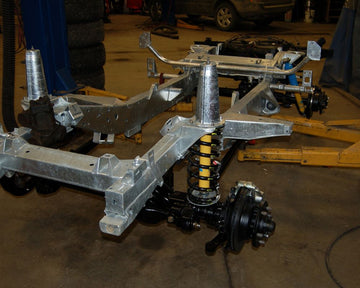Restoring a Land Rover is a labor of love for many of us. Whether it's a classic Defender or a modern Series, maintaining the integrity of the chassis is paramount. However, even the most experienced restorers can fall victim to common mistakes that can compromise the longevity and performance of their vehicle. In this blog post, we'll explore five of these pitfalls and provide insights on how to avoid them.
Neglecting Proper Inspection
Before diving into a restoration project, it's essential to conduct a thorough inspection of the chassis. Many issues, such as corrosion, rust, and structural damage, may not be immediately visible but can significantly impact the integrity of the chassis over time. Take the time to inspect every inch of the chassis, paying close attention to common problem areas such as the frame rails, cross members, and suspension mounts.
Skipping Surface Preparation
Proper surface preparation is crucial when restoring a Land Rover chassis. Neglecting to remove rust, paint, and debris can compromise the effectiveness of any coatings or treatments applied during the restoration process. Take the time to thoroughly clean and prep the chassis before applying any protective coatings or treatments to ensure maximum adhesion and longevity.
Choosing the Wrong Coating
Selecting the right coating for your Land Rover chassis is essential for long-term durability and protection against corrosion. While there are various options available, not all coatings are created equal. Avoid the mistake of choosing a coating based solely on price or availability. Instead, opt for high-quality coatings specifically designed for automotive applications and proven to withstand the rigors of off-road driving and exposure to the elements.
Overlooking Structural Reinforcement
During the restoration process, it's common for enthusiasts to focus solely on repairing visible damage without considering the structural integrity of the chassis as a whole. However, reinforcing key areas of the chassis can help prevent future issues and prolong its lifespan. Consider installing additional bracing, gussets, or reinforcements in critical areas prone to stress or fatigue to ensure your Land Rover can handle the demands of off-road driving.
Rushing the Restoration Process
Restoring a Land Rover chassis is a time-consuming endeavor that requires patience, attention to detail, and careful planning. Rushing through the restoration process can lead to overlooked issues, subpar workmanship, and ultimately, costly repairs down the line. Take your time, follow a systematic approach, and don't hesitate to seek professional assistance or guidance when needed to ensure your restoration project is a success.
Restoring a Land Rover chassis is a rewarding but challenging task that requires careful consideration and attention to detail. By avoiding these common mistakes and taking a proactive approach to maintenance and restoration, you can ensure your Land Rover remains a reliable and capable off-road companion for years to come.
Remember to prioritise proper inspection, surface preparation, coating selection, structural reinforcement, and patience throughout the restoration process to achieve the best results possible.
We offer customer support 24/7 at Shielder Chassis, give us a call if you encounter any problems.
